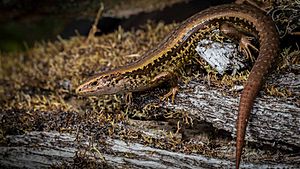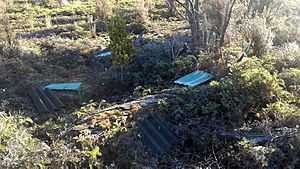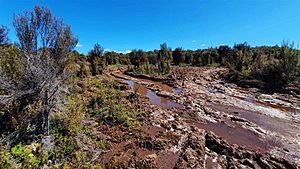Oligosoma albornense facts for kids
Quick facts for kids Oligosoma albornense |
|
|---|---|
 |
|
| Male Alborn skink | |
| Conservation status | |
 Nationally Critical (NZ TCS) |
|
| Scientific classification | |
| Genus: |
Oligosoma
|
| Species: |
albornense
|
| Synonyms | |
|
|
The Alborn skink (Oligosoma albornense) is a very rare lizard. It is only found in one small area in New Zealand. This special skink lives near Reefton. Scientists say it is "Nationally Critical." This means it is in great danger of disappearing forever. Its home is just about 2 hectares (about 5 acres) big.
Contents
Discovering the Alborn Skink
For many years, people thought the speckled skink was just one type of lizard. It seemed to live all over New Zealand. But scientists looked closer at its genes. They found out that it was actually many different skinks. These skinks look alike but are unique species.
In 1992, two scientists found a special group of speckled skinks. They were near Reefton on the West Coast of the South Island. Later surveys confirmed these skinks were different. In 2008, more studies showed they were genetically unique. Finally, in 2019, scientists officially named this new species. They called it Oligosoma albornense, or the Alborn skink. They also learned its closest relative is the Chesterfield skink.
Where the Name Comes From
The Alborn skink gets its name from the Alborn Coal Mine. This mine is where the skink was first found. The Alborn family ran the coal mine for many years. They operated it from 1908 to 1966.
What the Alborn Skink Looks Like
The Alborn skink is a long, thin lizard. It has a brown back with speckles. It also has a pale stripe along its sides. This stripe has jagged edges. Below that, there is a dark brown band. Underneath this band is another thin, pale stripe.
Its tail is usually as long as its body. The tail does not have the same stripes as its body. Alborn skinks have dark brown eyes. Their snout (nose area) is shaped like a wedge. Their chin and throat are grey. Unlike some other skinks, their belly is a yellow-orange color. This color turns grey partway down their tail. They can grow up to 87 mm long from snout to vent (where the tail begins). On average, they weigh about 11.5 grams.
Where the Alborn Skink Lives
The Alborn skink is endemic to New Zealand. This means it is found nowhere else in the world. It has only been seen in one small spot. This spot is the Alborn Coal Mine area. It is south of Reefton, near Big River. This area is about 550 meters (1,800 feet) above sea level. It is a cool place with lots of rain.
Alborn Skink Habitat
The Alborn Coal Mine was left empty for 30 years. That's when these skinks were first found there. They were living around old mining machines. The area had been cleared, but new native plants were growing back. Alborn skinks seem to like living in native shrubland. They also like open spots in beech forests.
They have also been found in nearby pākihi wetlands. Pākihi is a type of wet, boggy land. These skinks seem to be okay with wet conditions. When the pākihi floods after heavy rain, the skinks climb onto logs. They find high spots to stay out of the water.
Protecting the Alborn Skink
The Alborn skink is listed as "Nationally Critical." This is the highest threat level in New Zealand. Before 2015, only 7 records of this skink existed. By 2017, fewer than 20 individual skinks had ever been seen. Recent searches in their small 2-hectare home have found only one skink.
Because they live in such a tiny area, they are very vulnerable. This means they could easily disappear forever. They are also likely hunted by animals like mice, rats, mustelids (like stoats and ferrets), and weka.
The skink's habitat is supposed to be protected from vehicles. But in November 2020, four-wheel-drive vehicles drove through the area. They churned up the ground. They also destroyed covers for skink-monitoring pits. Vandals cut down trees to make tracks. They also broke fences and gates. Part of the skink's home was turned into a "mud hole." This kind of damage makes it even harder for these rare skinks to survive.



